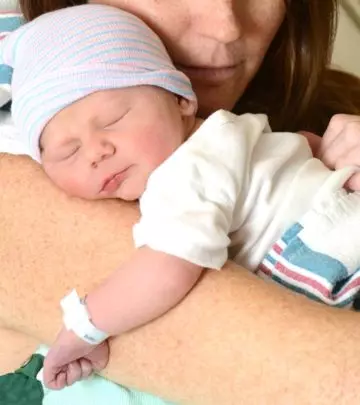
Image: iStock
Premature infants have difficulty in hearing and assimmilating words more than twice the babies who are born full-term. It is possibly so because the regions of the brain that program sounds aren’t adequately developed by the time the baby is born.
A rare study that has been conducted on 40 premature babies suggests that simulating an environment like that of mother’s womb with a mother’s voice recording and heartbeat could be a plausible way to correct or control such deficits.
Cognitive scientist Karin Stromsworld of Rutgers University in New Brunswick, New Jersey, explains that the fetus can begin to hear at about the 24th gestational week, which is when the neurons move to build connections in the auditory cortex – a part of the brain that deals with sound. The fetus develops the ability to hear sounds of low frequency in terms of mother’s heartbeat or in the form of the rhythm or melody of her voice. The sounds of higher frequency tones from outside into the mother’s womb are usually not lapped in. Scientists believe that it is possibly a way the child gets introduced to the rhythm and melody of speech even before it begins to hear and assimmilate the individual words. Perhaps the most important steps towards acquiring language early is hindered when the baby is born premature.
Amir Lahav, a neuroscientist at Harvard Medical School in Boston has to say that the premature babies are also exposed to bright lights, smells from chemicals, and shrill sounds of a hospital’s ICU, whereby the premature born babies don’t have the sensations they would otherwise have while in the womb. He adds that premies are too fragile to be held out of humidity and temperature controlled incubators even if it meant to be in the mothers arms. It is also a normal practice to obliterate light by covering the eyes of the premies and reduces the noise of high frquencies by providing earplugs to imporve the overall outcome.
Lahav and his team carried out a month-long experiment on parents of 40 prematurely born babies at Brigham and Women’s Hosptial in Boston. The mothers of half the infants were asked to sing and read “Twinkle, Twinkle, Little Star” and “Goodnight Moon” in a recording studio while also recording their heartbeats through a stethoscope connected to a microphone. The higher frequency tones from the recordings were removed and piped the remaining sound for 45-minute sessions making up to three hours per day into the incubators of 21 infants, while the rest of the infants received the regular care. At the end of 30 days, the ultrasound images of the brains of both the groups were compared.
Result
The Proceedings of the National Academy of Sciences reported that it was found that the babies who were exposed to the voices of their mothers had relatively thicker auditory cortices than that of the control group. While it is not certain whether the growth of auditory cortices growth proves a point, but common sense suggests that “bigger is better” with respect to development in the auditory cortices. The research team plans to observe the infant through the school-going age and assess any case of speech or hearing problems.
Stromsworld of Rutgers University says that the structural differences in brain after just 30 days fits in well with what the scientists already know about fetal brain development. On the other hand, she also believes that the study has a few weak points as well. She points to the fact that the treatment group had five more females than in the control group, and as nature would have it, female preemies perform better than males with regards to the language, and there is a chance that the imbalance would have altered to back a positive result. The other flaw she points out is that the group failed to compare the ‘before’ and ‘after’ ultrasounds to see how each the infant’s brain changed gradually. Lahav, however, says that the preemies had their routine ultrasound right after birth to confirm there were no brain injuries, but that the images were too course to use for comparison.
Lahav’s team results need further backing as he warns that the interventions might not necessarily evade the several health issues faced by preemies. But the study requires the babies to be exposed to womblike simulated sounds for at least three hours a day to set the brain on the right developmental track.












